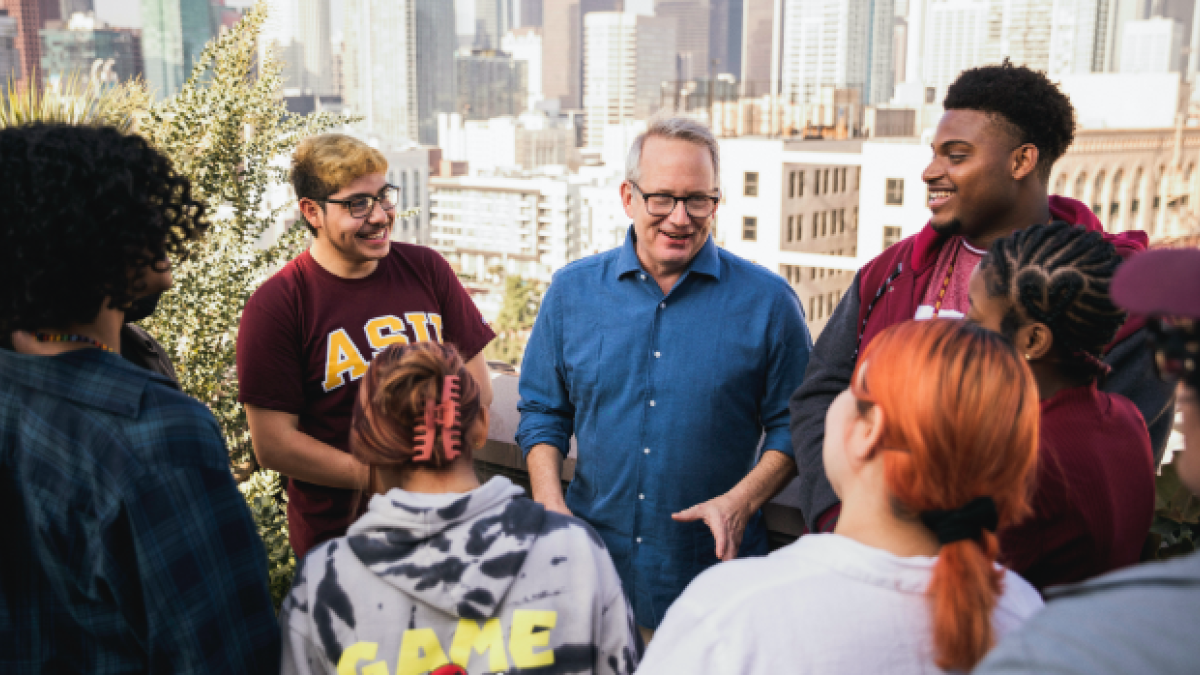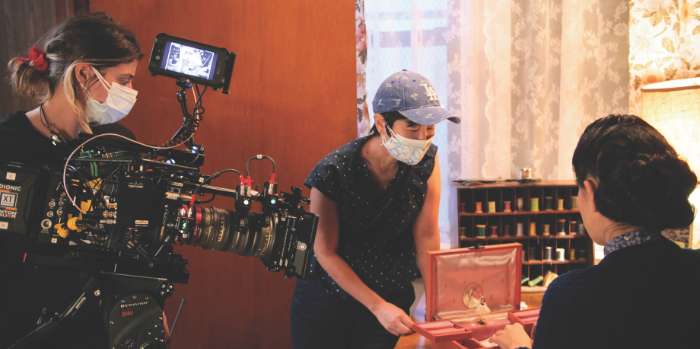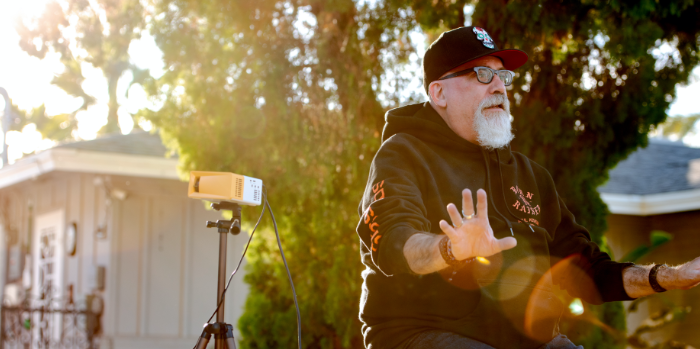Editor's note: This story originally appeared in the winter 2022 issue of ASU Thrive magazine.
When Hollywood independent filmmaker Ted Hope, producer of more than 70 indie films and now a professor at ASU’s Thunderbird School of Global Management, started shopping one of his first successful films, Ang Lee’s “The Wedding Banquet” back in 1993, “No one initially wanted it,” he recalls.
As a romance, the film followed the genre’s formula but featured gay lead characters, was in Chinese and felt like a film from the 1940s. When it finally was picked up by the Samuel Goldwyn Company, it garnered rave reviews, became an audience favorite and won the top prize at the Berlin Film Festival. When Hope later asked the jury what they liked about the film, “They said that it’s gay, Chinese and feels like a film from the 1940s,” Hope says.
That was one of the early lessons Hope learned as a filmmaker and artist: Stay true to the vision — when you do that, you will find an audience. Another learning that has driven Hope to produce films: Long-form storytelling matters.
“We need folks with new perspectives, from diverse backgrounds, who have a wide variety of life experiences, who are aware of the play between disciplines.”
— Ted Hope, professor in ASU’s Thunderbird School of Global Management
Long-form storytelling’s power
Sanjeev Khagram, director general and dean of the Thunderbird School of Global Management, recruited Hope to ASU from Amazon. There, Hope transformed Amazon Studios as co-head of movies where, among his accomplishments, he led the streamer’s entry into feature-film production and acquisitions. He greenlighted three Oscar winners, including “Sound of Metal,” as well as the Oscar-nominated “Time.” More recently, he shepherded through the new Adam Driver film, “Annette,” which he calls “a super rare distinctive film by one of the great filmmakers of the world.” This past summer, the movie won the best director award at Cannes for Leos Carax.
Hope currently is working on several new film productions and says that one thing remains the same over his entire career: Long-form storytelling, no matter whether in the form of a feature film or streaming series, remains as vibrant and popular as ever. The post-“Sopranos” explosion of high-quality bingeable television is one example. Another example of this popularity? During the pandemic, researchers found that the average American streamed eight hours of content per day and had logins for at least four streaming services.
One trick Hope’s learned: “You have to keep them hooked in the first 11 minutes. After somebody’s watched that much, they are supposedly much more prone to staying involved.”
Another reason for the enduring power of long-form storytelling, particularly film? It provides time to tell the story with nuance and complexity, which creates an immersiveness, says filmmaker Reina Higashitani, a professor in The Sidney Poitier New American Film School at ASU.
“I still have that feeling whenever I go to a movie, no matter what I watch.”
— Reina Higashitani, professor in ASU’s The Sidney Poitier New American Film School
For Higashitani, the power of the story is what first inspired her. She still remembers the feeling of being mesmerized by “Star Wars” as a young girl in Japan and coming out of the theater determined to make movies. “I still have that feeling whenever I go to a movie, no matter what I watch.”
Reina Higashitani works on her film about a Japanese American family’s resettlement years after WWII and their forced removal and incarceration.
Storytelling taps into a human need
As researchers note, human brains are hard-wired with a need for stories, and not just any story, but ones that follow a specific age-old pattern. The formula: A protagonist who has a goal is challenged and tested along the way, and then experiences an emotional transformation and creates a new normal.
“In a two-hour movie like ‘John Wick,’ those things can be very basic,” says Peter Murrieta, two-time Emmy Award-winning producer and director in residence for The Sidney Poitier New American Film School. He contrasts it with a TV series like “Ted Lasso,” where the characters’ challenges get ever more complex and varied.
The lasting appeal of a great film became clear to Murrieta when his 18-year-old son recently asked to watch Paul Thomas Anderson’s “There Will Be Blood” together.
“He told me that there’s a video game inspired by it,” Murrieta says. “Someone was inspired by that movie enough to make a whole video game.”
Even today, eons into human storytelling, “I think we’re at a very early stage in storytelling,” Hope says, even though today’s stories use many of the same themes as tales told throughout human history. “How is the story different when it’s a game, a social network, a limited series, a documentary series, if it’s interactive?” he asks. “A lot has yet to be done.”
Ultimately, Hope says, long-form storytelling still wins the day with audiences, and allows the parsing of complex stories for streaming TV and many other immersive experiences.
Balancing art and business to bring projects to life
One reason Hope came to ASU is to help other creatives collaborate across disciplines and balance art with budgets, revenues and profits. A new program, the Master of Arts in Global Affairs and Management: Creative Industries, kicked off this past fall semester in downtown Los Angeles at the historic Herald Examiner Building. The program is powered by Thunderbird with support from the Herberger Institute for Design and the Arts.
“Hope will use his visionary storytelling talents and practical and entrepreneurial experience to help us produce a graduate degree like no other in the world,” Khagram says. “It will also provide students invaluable insights into 21st-century creative processes and enterprises.”
Emmy award-winning producer and writer Peter Murrieta teaches at ASU in Tempe and Los Angeles.
Hope draws on his success selling “The Wedding Banquet” to Samuel Goldwyn Jr. as an example of what he hopes students will learn in the program.
“Goldwyn asked us: ‘Are you businessmen or are you artists?’ I said, ‘Both.’ And he said, ‘No, you have to choose.’”
Hope disagrees. Part of his success, Hope says, is his ability to straddle both worlds to showcase his artistic vision in the world. That financial acumen, combined with the ability to have creative collaborations with many other people, is the key to a successful career in film, he says.
“We need folks with new perspectives, from diverse backgrounds, who have a wide variety of life experiences, who are aware of the play between disciplines,” Hope says.
That’s why he helped to spearhead the program, intended for managers who want to learn creative competencies and for creatives seeking management expertise.
“Most weekends, once it gets dark, there will be people sitting on bean bags watching a movie. And I’m upstairs looking out my window, and if I squint my eyes, it’s not that different than a campfire from who knows what era, surrounded by people telling a story.”
— Peter Murrieta, director-in-residence, The Sidney Poitier New American Film School
The magic of storytelling
In the end, the creative process is all about the story, whether screened in a theater, on a streaming service, on a phone or with a virtual reality headset.
“Stories give us knowledge, a sense of adventure, the feeling that we’re not alone,” Murrieta explains.
And often people want to experience those stories with other people. Murrieta recalls that during the pandemic, with movie theaters across the country shuttered, his neighbor popped up an inflatable screen in the front yard.
“Most weekends, once it gets dark, there will be people sitting on bean bags watching a movie,” Murrieta says. “And I’m upstairs looking out my window, and if I squint my eyes, it’s not that different than a campfire from who knows what era, surrounded by people telling a story.”
Top photo: Ted Hope (center) discusses the future of storytelling with Los Angeles-based students.
Written by Marcus Baram
More Arts, humanities and education

ASU professor's project helps students learn complex topics
One of Arizona State University’s top professors is using her signature research project to improve how college students learn science, technology, engineering, math and medicine.Micki Chi, who is a…

Award-winning playwright shares her scriptwriting process with ASU students
Actions speak louder than words. That’s why award-winning playwright Y York is workshopping her latest play, "Becoming Awesome," with actors at Arizona State University this week. “I want…

Exceeding great expectations in downtown Mesa
Anyone visiting downtown Mesa over the past couple of years has a lot to rave about: The bevy of restaurants, unique local shops, entertainment venues and inviting spaces that beg for attention from…




